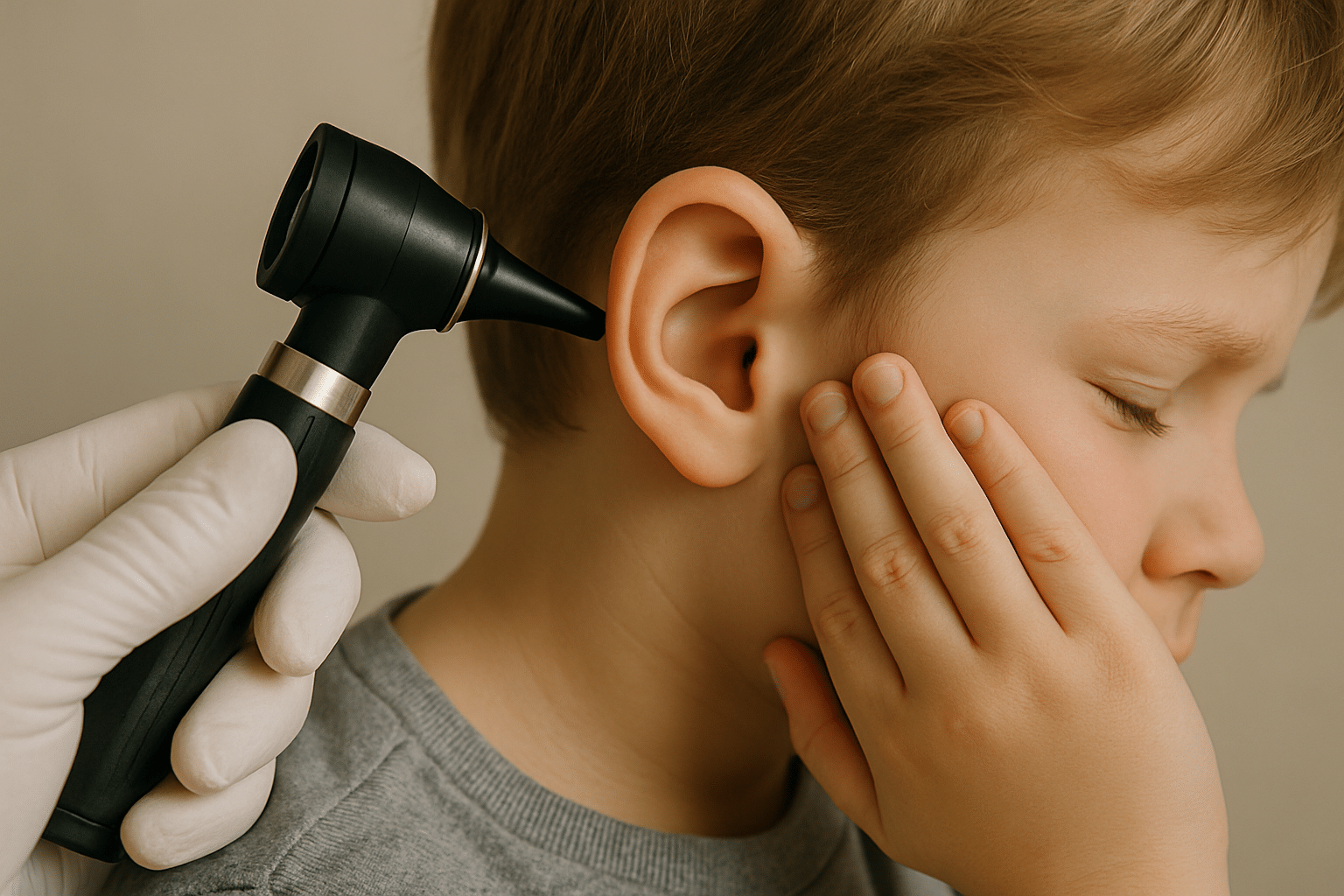

Glue ear is a condition that affects many young children; glue ear symptoms emerge when fluid builds up behind the eardrum, and these can lead to hearing problems that may disrupt language and communication skills. These signs are often subtle, making it hard for parents to notice them early on. Some behaviours may be mistaken for part of normal growth, which delays attention to possible hearing concerns.
Recognising glue ear symptoms early gives children the best chance of avoiding lasting hearing loss and related speech difficulties. Early awareness helps children learn to speak clearly and build social confidence in everyday settings. This guide provides parents with key information on recognising signs, understanding risks, and knowing when to seek proper care.
Glue ear is a condition where sticky fluid builds up in the space behind the eardrum. The eardrum normally vibrates freely when sound enters the ear canal, but when fluid is present, these vibrations become limited. As a result, sounds become muffled and less clear. In most cases, glue ear develops due to blocked Eustachian tubes. These narrow tubes connect the middle ear to the back of the throat and help maintain air pressure. When the tubes do not work properly, fluid becomes trapped.
Children are more likely to develop glue ear because their Eustachian tubes are shorter and narrower than those of adults. Seasonal colds, allergies, and repeated ear infections can also contribute to the problem. Enlarged adenoids may block proper drainage of the ear, creating further difficulties. Although glue ear is not usually painful, it often persists for weeks or months. Parents might notice no obvious discomfort in their child, which is why early detection becomes challenging. Understanding these causes helps parents see why children face higher risks of hearing issues in the early years.
Glue ear symptoms may appear gradually. Many children adapt to the change in hearing without complaint, which can confuse parents. One of the earliest signs is muffled hearing. Children may not respond when called from another room, or they may ask for repetition during conversations. Teachers often notice when children do not follow classroom instructions.
Frequent ear infections also provide a clue. While not every ear infection leads to glue ear, repeated infections raise the likelihood. A child who turns the television volume higher than usual or watches people’s lips closely when they speak may also be showing signs of hearing difficulties. Parents might see changes in social behaviour too. A child with glue ear can appear withdrawn or inattentive. Sometimes the behaviour looks like daydreaming, but it may reflect hearing struggles.
Speech development delays provide another important clue. Clear speech relies on consistent exposure to sounds and words. When hearing is limited, children may mispronounce words or struggle to learn new vocabulary. Recognising these early symptoms allows parents to take action before communication skills fall behind.
Early awareness of glue ear symptoms can make a significant difference in a child’s development. Timely support prevents further complications and helps children thrive in speech, learning, and social interaction.
Glue ear often causes temporary hearing loss, but when left unmanaged, it may result in more serious, lasting problems. Persistent fluid build-up can damage delicate parts of the middle ear, increasing the risk of permanent hearing difficulties over time.
Identifying glue ear symptoms early gives children a better chance of full recovery without long-term complications. With appropriate monitoring and care, potential damage can be prevented, ensuring healthier ear function as the child grows.
Children learn to speak by listening to the sounds around them. When hearing is impaired, even slightly, it becomes harder for them to recognise speech patterns, develop vocabulary, and pronounce words correctly.
Early treatment for glue ear restores access to these essential sounds, supporting more natural language development. Clear hearing during the early years lays a strong foundation for confident and effective communication later in life.
Hearing clearly is crucial in the classroom, where instructions, discussions, and group activities form a large part of learning. Children with untreated glue ear may struggle to follow along, which can affect progress across all subjects.
By detecting glue ear symptoms early, parents and teachers can ensure children are given the help they need. Whether through medical support or temporary accommodations, early action helps keep learning on track.
Social skills are shaped through everyday conversation, play, and group interaction. If a child cannot hear properly, they may miss key cues, leading to misunderstandings or social withdrawal.
Spotting glue ear symptoms early enables children to re-engage with friends and peers more easily. Improved hearing strengthens their ability to communicate, take turns, and form meaningful relationships in social settings.
Unexplained behavioural changes can be frustrating and worrying for parents. When children appear to ignore instructions or act out, it’s easy to assume they’re misbehaving, when in fact they may simply not be hearing well.
Early diagnosis of glue ear provides clarity and reassurance. Knowing the cause allows families to focus on the right kind of support, reducing uncertainty and making everyday life less stressful for both child and parent.
Hearing loss caused by glue ear is usually temporary, but the effects can still be serious. Sound enters the ear canal as vibrations, which travel through the eardrum and middle ear bones to reach the inner ear. Fluid behind the eardrum prevents these vibrations from moving freely, which reduces sound clarity. The result is a form of conductive hearing loss.
Young children rely heavily on hearing during the critical period of language development. If glue ear is left untreated, children may find it hard to understand spoken words or follow stories read aloud. This reduced exposure to clear sounds may slow their ability to form sentences, learn grammar, and expand vocabulary. Speech may sound unclear because children cannot hear themselves accurately.
Beyond language, hearing difficulties affect attention and concentration. When listening requires more effort, children may become tired more quickly in lessons. Over time, this can influence academic performance and classroom participation. Awareness of these effects highlights why parents must take glue ear symptoms seriously, even when children seem to manage daily life.
Parents are often the first to notice subtle changes in their child’s behaviour. Observing how children react to everyday sounds helps identify possible hearing problems. For example, if a child does not turn when called softly or seems unaware of background noises, parents should take note. Comparing how the child behaves in quiet spaces versus noisy environments also provides useful information.
Keeping track of speech progress is important as well. If words are unclear or language skills seem delayed compared with peers, hearing problems may be involved. Parents should trust their instincts if something feels unusual. Even if a child appears to cope, delays in getting help can lead to further challenges. Communication with teachers also matters. Teachers see children in group settings and may notice listening difficulties that parents miss at home. Parents who actively monitor and record these signs provide valuable details for doctors and hearing specialists.
Parents often wonder how long to wait before seeking professional advice. In some cases, glue ear symptoms improve on their own within a few weeks. However, if muffled hearing continues for more than a month, it is wise to consult a specialist. Parents should also seek advice if a child shows consistent difficulty in following speech or if speech development appears delayed compared with peers.
Frequent ear infections also justify medical review. Even if infections clear up, fluid can remain trapped behind the eardrum for some time. Children who are struggling at school, seem frustrated in group activities, or rely heavily on lip reading may also need professional support. Hearing specialists use simple tests to check how well sound travels through the ear. A proper diagnosis gives parents clarity and ensures children receive the right treatment plan.
Treatment for glue ear depends on how severe the symptoms are and how long the condition lasts. In some children, the fluid clears up naturally within a few months. During this period, specialists may recommend regular monitoring with follow-up appointments. If hearing does not improve, treatment may be needed.
One common option is the use of small ventilation tubes, also called grommets, inserted into the eardrum through a short operation. These tubes allow air into the middle ear and help fluid drain away. Another possible treatment is the removal of enlarged adenoids if they contribute to blockages. In some cases, temporary hearing aids may be offered to support children until the fluid clears.
Each option has advantages depending on the child’s needs. The goal is to restore normal hearing quickly to avoid delays in speech and learning. Parents should discuss all available choices with specialists to understand what works best for their child.
Ignoring glue ear symptoms may cause long-lasting consequences. Hearing loss during childhood affects not only communication but also confidence and relationships. Taking early action provides children with the opportunity to thrive. Parents who recognise signs early, arrange timely check-ups, and follow treatment plans protect their child’s future well-being.
Dr Benjamin Chan, Head and Neck Surgeon, offers expert advice and treatment for glue ear. Consulting a professional ensures children receive tailored care based on their needs. Parents should not wait until school struggles become obvious. Support at the earliest stage makes a meaningful difference to development. With the right guidance, children can avoid complications and enjoy clearer communication with family, teachers, and friends.
Active involvement in a child’s hearing care journey shows children that their needs are understood. It also creates a positive routine where children feel supported and confident. By responding quickly to glue ear symptoms, parents give children the best chance to reach milestones in language, learning, and social interaction.